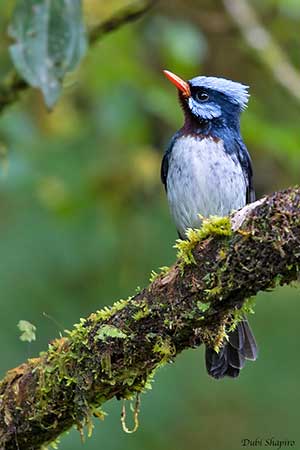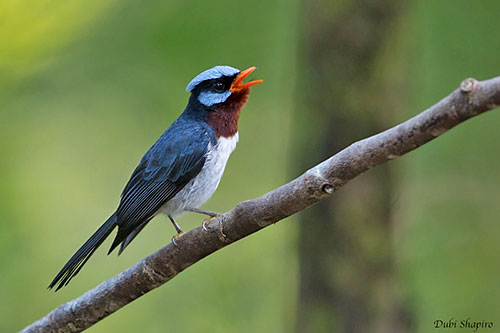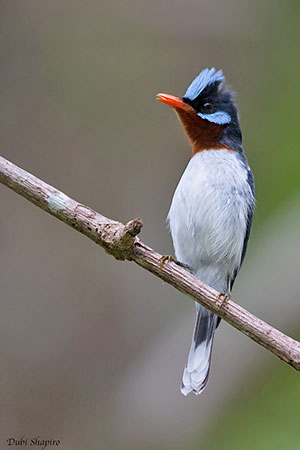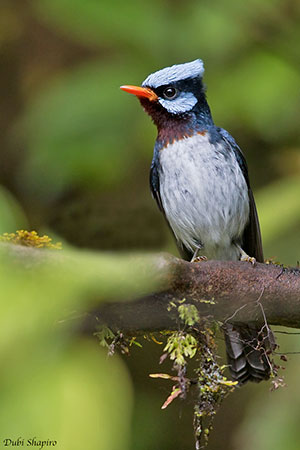
Fr: Monarque à crête bleue
Ang: Azure-crested Flycatcher
All: Schmuckmonarch
Esp: Monarca Crestiazul
Ita: Pigliamosche crestazzurra
Nd: Blauwkapmonarch
Sd: azurkronad monark
Photographer:
Dubi Shapiro
Dubi Shapiro Photo Galleries & Dubi Shapiro's Pictures on IBC
Text by Nicole Bouglouan
Sources:
HANDBOOK OF THE BIRDS OF THE WORLD Vol 11 by Josep del Hoyo, Andrew Elliott and David Christie - Lynx Edicions - ISBN: 849655306X
BirdLife’s Globally Threatened Bird Forums
CREAGUS - MONARCHS Monarchidae
Encyclopaedia Britannica – Monarch bird
Wikipedia, the free encyclopaedia
Monarchidae - Monarchs, Paradise Flycatchers & Allies
Azure-crested Flycatcher
Myiagra azureocapila
Passeriformes Order – Monarchidae Family
INTRODUCTION:
Until recently, the Azure-crested Flycatcher was considered conspecific with the Chestnut-throated Flycatcher (M. castaneigularis), but they are now two distinct full species.
The Azure-crested Flycatcher is restricted to the island of Taveuni in N Fiji, where all individuals are considered to be a single population throughout a range of only 540 km². The species is endemic to Fiji Islands. It was first described in 1875 by Edgar Leopold Layard, a British diplomat, naturalist and ornithologist.
The Azure-crested Flycatcher frequents dense mature forests, and feeds on insects and spiders. It is rare to common throughout its restricted range, and deforestation caused by increasing human population is a potential future threat for this species, currently classified as Near Threatened.

DESCRIPTION OF THE BIRD:
Biometrics:
Length: 15-17 cm
Weight: 10-16 g
The Azure-crested Flycatcher adult male has dark slate-blue upperparts. Wings and tail are black with blue wash.
Chin and throat are bright chestnut and contrast strongly with the white underparts.
On the head, crest and cheeks are iridescent pale blue and contrast with the black eye stripe. The rest of the head is dark blue.
The bill is bright orange. Its broad base is considered to be an adaptation for catching prey in flight. The eyes are very dark, almost blackish. Legs and feet are pale grey.
The female (not displayed) differs by its mostly brownish-grey upperparts. The black wings and tail are washed brownish. Two pale wingbars are formed by the pale tips of median and greater wing-coverts.
On the underparts, chin and throat are bright brown. Rest of underparts are whitish with rufous spots on breast sides and flanks.
On the head, crown and nape are tinged slate-blue. We can see a blackish area around the eye, surrounded by white from lores to cheeks. There is a narrow, white eyering. The bill is duller than that of the male.
The immature resembles female but it has duller plumage and dark bill.
RANGE:
The Azure-crested Flycatcher is found in Taveuni Island, in N Fiji.
HABITAT:
The Azure-crested Flycatcher lives in dense, mature hilly and montane forests.
CALLS AND SONGS: SOUNDS BY XENO-CANTO
The Azure-crested Flycatcher utters pleasant, drawn-out, slurred whistles. The song is a whistled “weet-weet-weet…” or a drawn-out, harsher but slurred “weeeer”.
The call is a buzzy phrase “zwi-zwi-zwi…” given rapidly.

BEHAVIOUR IN THE WILD:
The Azure-crested Flycatcher feeds on insects and spiders. It forages mainly in middle and low levels of the trees, and rarely in the canopy. It gleans prey from foliage, but it also sallies for flying insects from a perch and may hover sometimes in front of the vegetation. It is usually very active and often changes perches.
It is generally seen in pairs or in family group of three birds. It may join mixed-species foraging flocks.
The Monarchidae are typically monogamous, and both mates share the nesting duties. The displays are mostly simple postures accompanied by much calling.
In species of genus Myiagra, the copulation occurs during the late stage of the nest-building, and without ceremony. They are solitary nesters.
The Azure-crested Flycatcher is sedentary in its range.
This species is very agile inflight, especially while foraging for insects.

REPRODUCTION OF THIS SPECIES:
The breeding season takes place between May and January. Both adults build an open cup-shaped nest, a flimsy structure of fine black plant fibres. The cup is lined with feathers. The nest is placed in low shrub.
The female lays a single whitish egg with dark markings. Both adults incubate and tend the chicks.
No more information.
PROTECTION / THREATS / STATUS:
The Azure-crested Flycatcher has restricted range of 540 km² on an island. It is threatened by deforestation for farming, following the increase of the human population.
The population of this species is suspected to be declining, and the Azure-crested Flycatcher is currently classified as Near Threatened.
